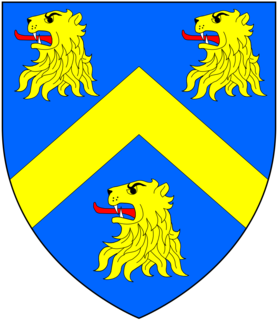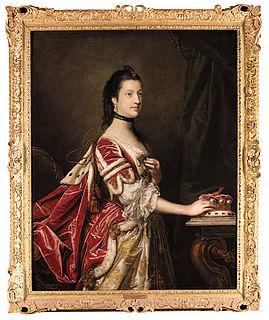Related Research Articles

Duke of Somerset, from the county of Somerset, is a title that has been created five times in the peerage of England. It is particularly associated with two families: the Beauforts, who held the title from the creation of 1448, and the Seymours, from the creation of 1547, in whose name the title is still held. The present dukedom is unique, in that the first holder of the title created it for himself in his capacity of Lord Protector of the Kingdom of England, using a power granted in the will of his nephew King Edward VI.

Duke of Atholl, alternatively Duke of Athole, named after Atholl in Scotland, is a title in the Peerage of Scotland held by the head of Clan Murray. It was created by Queen Anne in 1703 for John Murray, 2nd Marquess of Atholl, with a special remainder to the heir male of his father, the 1st Marquess.

Duke of Northumberland is a noble title that has been created three times in English and British history, twice in the Peerage of England and once in the Peerage of Great Britain. The current holder of this title is Ralph Percy, 12th Duke of Northumberland.

The title of Earl of Northumberland has been created several times in the Peerage of England and of Great Britain, succeeding the title Earl of Northumbria. Its most famous holders are the House of Percy, who were the most powerful noble family in Northern England for much of the Middle Ages. The heirs of the Percys, via a female line, were ultimately made Duke of Northumberland in 1766, and continue to hold the earldom as a subsidiary title.

The title Baron Percy has been created several times in the Peerage of England. The first, soon after 1066, a feudal barony rather than a barony by writ, which continued in parallel with the later baronies by writ, until the abolition of feudal tenure by the Tenures Abolition Act 1660. The second, created by writ in 1299, became extinct in 1517. The third, created by writ in 1557, became extinct in 1670. The present creation was in 1722, by writ of summons.

Baron Leconfield, of Leconfield in the East Riding of the County of York, is a title in the Peerage of the United Kingdom. It was created in 1859 for Col. George Wyndham (1787–1869). He was the eldest illegitimate son and adopted heir of George Wyndham, 3rd Earl of Egremont (1751–1837), from whom he inherited Petworth House in Sussex, Egremont Castle and Cockermouth Castle in Cumbria and Leconfield Castle in Yorkshire, all formerly lands of Josceline Percy, 11th Earl of Northumberland (1644–1670), inherited by Charles Seymour, 6th Duke of Somerset (1662–1748) on his marriage to the Percy heiress Elizabeth Percy (1667–1722) and inherited as one of the co-heirs of his son Algernon Seymour, 7th Duke of Somerset, 1st Earl of Egremont (1684–1750) by the latter's nephew Sir Charles Wyndham, 4th Baronet (1710–1763) of Orchard Wyndham in Somerset, who inherited by special remainder the Earldom of Egremont. The 1st Baron's eldest son, the second Baron, represented West Sussex in the House of Commons as a Conservative. He was succeeded by his eldest son, the third Baron, who served as Lord Lieutenant of Sussex from 1917 to 1949. The latter's nephew, the sixth Baron, served as Private Secretary to Prime Minister Harold Macmillan from 1957 to 1963. In 1963, four years before he succeeded his father in the barony of Leconfield, the Egremont title held by his ancestors was revived when he was raised to the peerage as Baron Egremont, of Petworth in the County of Sussex. As of 2017 the titles are held by his son, the seventh Baron. Known as Max Egremont, he is a biographer and novelist.

Admiral Algernon Percy, 4th Duke of Northumberland,, styled Lord Algernon Percy from birth until 1816 and known as Lord Prudhoe between 1816 and 1847, was a British naval commander, explorer and Conservative politician.

Henry George Percy, 7th Duke of Northumberland,, styled Lord Warkworth between 1865 and 1867 and Earl Percy between 1867 and 1899, was a British Conservative politician. He served as Treasurer of the Household under Benjamin Disraeli between 1874 and 1875 and was Chairman of the National Union of Conservative and Constitutional Associations from 1879 to 1883.

The House of Percy is an English noble family. They were one of the most powerful noble families in Northern England for much of the Middle Ages, known for their long rivalry with another powerful northern English family, the House of Neville.

General Algernon Seymour, 7th Duke of Somerset, styled Earl of Hertford until 1748, of Petworth House in Sussex, was a British Army officer and Whig politician who sat in the House of Commons from 1708 until 1722 when he was raised to the House of Lords as Baron Percy.

Algernon George Percy, 6th Duke of Northumberland,, styled Lord Lovaine between 1830 and 1865 and Earl Percy between 1865 and 1867, was a British Conservative politician. He held office under the Earl of Derby as Paymaster-General and Vice-President of the Board of Trade in 1859 and under Benjamin Disraeli as Lord Privy Seal between 1878 and 1880.

Hugh Percy, 1st Duke of Northumberland,, was an English peer, landowner, and art patron.

George Percy, 5th Duke of Northumberland PC, styled Lord Lovaine between 1790 and 1830 and known as the Earl of Beverley between 1830 and 1865, was a British Tory politician. He served as Captain of the Yeomen of the Guard under Sir Robert Peel between 1842 and 1846. He succeeded to his peerage on 12 February 1865, after the death of his childless cousin Algernon Percy.

Earl of Egremont was a title in the Peerage of Great Britain. It was created in 1749, along with the subsidiary title Baron of Cockermouth, in Cumberland, for Algernon Seymour, 7th Duke of Somerset, with remainder to his nephews Sir Charles Wyndham, 4th Baronet, of Orchard Wyndham, and Percy Wyndham-O'Brien. The Duke had previously inherited the Percy estates, including the lands of Egremont in Cumberland, from his mother Lady Elizabeth Percy, daughter and heiress of Joceline Percy, 11th Earl of Northumberland. In 1750 Sir Charles Wyndham succeeded according to the special remainder as second Earl of Egremont on the death of his uncle. His younger brother Percy Wyndham-O'Brien was created Earl of Thomond in 1756.

Algernon Percy, 1st Earl of Beverley FSA, styled Lord Algernon Percy between 1766 and 1786 and known as the Lord Lovaine between 1786 and 1790, was a British politician who sat in the House of Commons from 1774 to 1786 when he succeeded to the Peerage.

Elizabeth Percy, Duchess of Northumberland, also suo jure2nd Baroness Percy, was a British peer.
Peter Burrell FRS was a British politician and barrister.

Percy Wyndham-O'Brien, 1st Earl of Thomond was a British Member of Parliament and an Irish peer.
Isabella Susan Percy, Countess of Beverley, formerly Isabella Susan Burrell, was the wife of Algernon Percy, 1st Earl of Beverley, and the mother of the 5th Duke of Northumberland.
Frances Julia Percy, Duchess of Northumberland, formerly Frances Julia Burrell, was the second wife of Hugh Percy, 2nd Duke of Northumberland, and the mother of the 3rd and 4th Dukes.
References
- ↑ "No. 13249". The London Gazette . 26 October 1790. p. 646.
- ↑ "No. 12514". The London Gazette . 27 January 1784. p. 2.